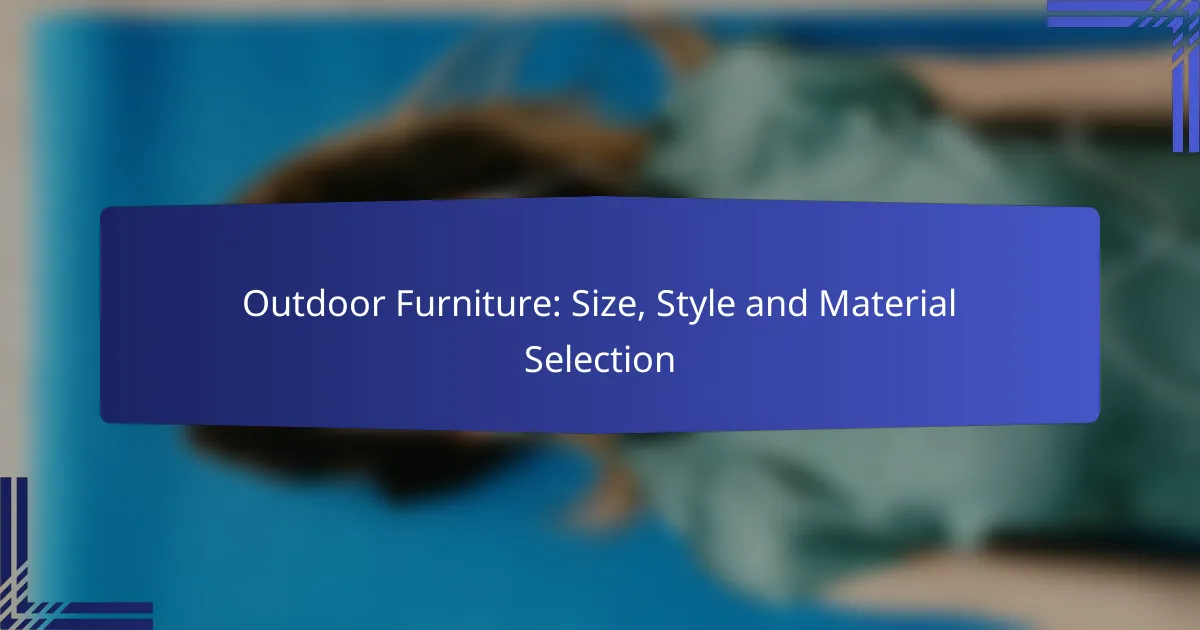Selecting the right outdoor furniture involves careful consideration of size, style, and material to enhance your outdoor space. For smaller patios, prioritize compact and functional pieces that maximize usability without overwhelming the area. In 2023, trends lean towards modern minimalist designs and rustic aesthetics, while durable materials like weather-resistant metals and teak wood ensure longevity against the elements.

What are the best outdoor furniture sizes for small patios?
The best outdoor furniture sizes for small patios typically prioritize compactness and functionality. Aim for pieces that maximize seating and usability without overwhelming the space, generally keeping dimensions under 2 meters in length for sofas and around 1 meter for tables.
Compact seating options
For small patios, consider compact seating options such as loveseats, benches, or folding chairs. A loveseat measuring around 1.5 meters can comfortably seat two people while taking up minimal space. Look for chairs that can be easily stored or stacked when not in use to keep the area open.
Additionally, modular seating can be a great choice, allowing you to rearrange pieces based on your needs. Opt for lightweight materials like aluminum or resin for easy movement.
Space-saving tables
Space-saving tables are essential for maximizing functionality on small patios. Round tables with diameters of 60 to 80 centimeters can fit snugly into corners while providing enough surface area for drinks and snacks. Consider drop-leaf or extendable tables that can be adjusted based on the number of guests.
Another option is nesting tables, which can be tucked away when not in use. Look for tables made from weather-resistant materials to ensure durability against outdoor elements.
Multi-functional furniture
Multi-functional furniture is ideal for small patios, combining utility with space efficiency. Consider benches that double as storage units or ottomans that can serve as both seating and tables. This approach helps keep your patio organized and clutter-free.
Another practical choice is a coffee table that can convert into a dining table, allowing for versatility in use. Ensure that any multi-functional pieces are sturdy and designed for outdoor conditions to enhance longevity.

What styles of outdoor furniture are trending in 2023?
In 2023, outdoor furniture trends emphasize a blend of functionality and aesthetics, with a focus on modern minimalist designs, rustic wooden furniture, and bohemian chic aesthetics. These styles cater to various tastes and outdoor spaces, making it easier for homeowners to create inviting and stylish environments.
Modern minimalist designs
Modern minimalist designs prioritize clean lines and simplicity, often utilizing materials like metal and glass. This style is ideal for small patios or balconies, as it creates an uncluttered look while maximizing space.
When selecting modern minimalist furniture, consider pieces that offer multi-functionality, such as benches with storage or tables that can be easily moved. Neutral colors like white, gray, and black are popular, allowing for easy integration with various outdoor settings.
Rustic wooden furniture
Rustic wooden furniture brings warmth and natural charm to outdoor spaces, often featuring reclaimed or sustainably sourced wood. This style works well in gardens or larger backyards, creating a cozy atmosphere that encourages relaxation and social gatherings.
When choosing rustic wooden pieces, look for durable finishes that can withstand weather conditions, such as teak or cedar. Regular maintenance, like oiling or sealing, will help preserve the wood’s integrity and appearance over time.
Bohemian chic aesthetics
Bohemian chic aesthetics embrace vibrant colors, eclectic patterns, and a mix of textures, making outdoor spaces feel inviting and personalized. This style often incorporates various materials, including textiles, wicker, and ceramics, allowing for creative expression.
To achieve a bohemian look, consider layering different seating options, such as poufs and cushions, and incorporating decorative elements like lanterns or rugs. Plants and greenery can enhance this aesthetic, creating a lush, vibrant outdoor retreat.

What materials are ideal for outdoor furniture durability?
Durable outdoor furniture materials are essential for withstanding various weather conditions while maintaining aesthetic appeal. The best options typically include weather-resistant metals, high-density polyethylene (HDPE), and teak wood, each offering unique benefits for longevity and maintenance.
Weather-resistant metals
Weather-resistant metals, such as aluminum and stainless steel, are excellent choices for outdoor furniture due to their strength and resistance to rust and corrosion. Aluminum is lightweight, making it easy to move, while stainless steel offers a sleek, modern look and superior durability.
When selecting metal furniture, consider powder-coated finishes that provide additional protection against the elements. Regular maintenance, such as cleaning and inspecting for scratches, can help prolong the lifespan of metal furniture.
High-density polyethylene (HDPE)
High-density polyethylene (HDPE) is a synthetic material known for its exceptional durability and resistance to fading, cracking, and peeling. It is often used in outdoor furniture because it can withstand harsh weather conditions without deteriorating.
HDPE furniture is typically low-maintenance and easy to clean, making it a practical choice for outdoor settings. Look for products that are UV-stabilized to ensure they maintain their color and integrity over time.
Teak wood advantages
Teak wood is highly regarded for outdoor furniture due to its natural oils that provide inherent resistance to moisture, insects, and decay. This makes teak an excellent option for outdoor environments, particularly in humid or rainy climates.
While teak furniture can be more expensive initially, its longevity and minimal maintenance requirements often justify the investment. To maintain its rich color, consider applying teak oil periodically, or allow it to weather to a silver-gray patina for a more rustic look.

How to choose outdoor furniture for coastal climates?
Choosing outdoor furniture for coastal climates requires selecting materials that can withstand salty air, high humidity, and intense sunlight. Focus on corrosion-resistant materials, UV protection features, and moisture-resistant finishes to ensure durability and longevity.
Corrosion-resistant materials
For coastal areas, opt for materials like aluminum, stainless steel, and certain types of teak that resist rust and corrosion. Aluminum is lightweight and often powder-coated for additional protection, while stainless steel offers a sleek look with high durability.
Consider synthetic materials such as high-density polyethylene (HDPE) or resin wicker, which mimic traditional styles but are impervious to moisture and salt. These options can provide a cost-effective and low-maintenance solution for outdoor settings.
UV protection features
UV protection is crucial for outdoor furniture exposed to direct sunlight. Look for fabrics and finishes that are specifically labeled as UV-resistant to prevent fading and degradation over time. Outdoor cushions should ideally have a UV rating of at least 1,000 hours.
Additionally, consider furniture with UV-stabilized colors or coatings that maintain their appearance despite prolonged sun exposure. This will help preserve the aesthetic appeal of your outdoor space while reducing the frequency of replacements.
Moisture-resistant finishes
Moisture-resistant finishes are essential for protecting wood and metal furniture from the effects of humidity and rain. Look for finishes that are water-repellent or treated with sealants that prevent moisture absorption, thereby reducing the risk of mold and mildew.
Teak oil or marine varnish can be effective for wood furniture, while powder-coated metal provides a protective barrier against moisture. Regular maintenance, such as reapplying finishes annually, can help extend the life of your outdoor furniture in coastal environments.

What are the key factors in outdoor furniture selection?
When selecting outdoor furniture, key factors include comfort, style compatibility with your home, and budget considerations. Each of these elements plays a crucial role in ensuring that your outdoor space is both functional and aesthetically pleasing.
Comfort and ergonomics
Comfort is paramount when choosing outdoor furniture, as it directly affects how much you enjoy your space. Look for pieces that offer adequate support and fit your body well, such as chairs with proper back support and cushions that provide a comfortable seating experience.
Consider the ergonomics of your selections. For example, dining chairs should allow for easy movement and provide enough space for your legs. Testing furniture in-store or checking reviews online can help you gauge comfort levels before making a purchase.
Style compatibility with home
Outdoor furniture should complement the architectural style and color scheme of your home. Whether your home is modern, rustic, or traditional, choose materials and designs that harmonize with your existing outdoor decor.
For instance, a sleek metal set might suit a contemporary home, while wooden furniture could enhance a more classic aesthetic. Consider using a cohesive color palette to tie your outdoor space together, making it visually appealing and inviting.
Budget considerations
Your budget is a critical factor in outdoor furniture selection. Prices can vary widely based on materials, brand, and design, so it’s essential to set a realistic budget before shopping. Expect to spend anywhere from a few hundred to several thousand dollars, depending on your needs.
Look for sales or consider purchasing in sets to get better value. Additionally, investing in durable materials may save you money in the long run, as they often require less maintenance and replacement over time.

How to maintain outdoor furniture longevity?
To ensure the longevity of outdoor furniture, regular maintenance is essential. This includes cleaning, proper storage during off-seasons, and applying protective coatings to shield against the elements.
Regular cleaning routines
Establishing a regular cleaning routine is crucial for maintaining outdoor furniture. Use a mild soap solution and a soft brush or cloth to remove dirt and grime, ideally every few weeks. For materials like wood or metal, consider using specialized cleaners to prevent damage.
Be mindful of the specific material of your furniture; for instance, wicker may require gentle cleaning to avoid fraying, while metal can benefit from a wax finish to prevent rust. Always rinse thoroughly to remove any soap residue.
Seasonal storage tips
Proper seasonal storage can significantly extend the life of outdoor furniture. During harsh weather, such as winter or heavy rain, store furniture indoors or use protective covers. Ensure the furniture is clean and dry before storing to prevent mold and mildew.
If indoor storage isn’t an option, consider using breathable covers that fit snugly to keep moisture out. Elevating furniture off the ground with pallets or blocks can also help prevent water damage.
Protective coatings
Applying protective coatings is an effective way to enhance the durability of outdoor furniture. For wooden pieces, a high-quality sealant or stain can protect against moisture and UV damage. Reapply these coatings annually or as needed based on exposure to the elements.
Metal furniture can benefit from a rust-inhibiting primer and paint, while plastic furniture may require UV protectants to prevent fading. Always follow the manufacturer’s recommendations for the best results.
